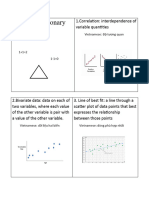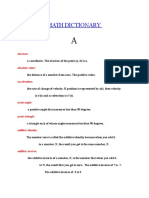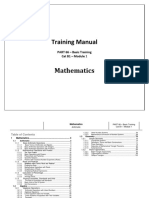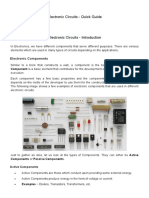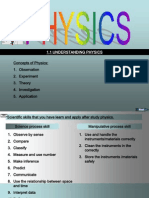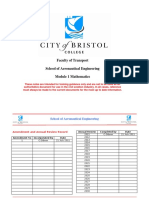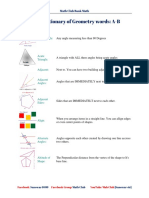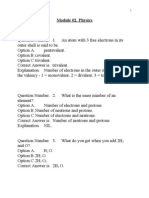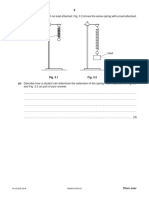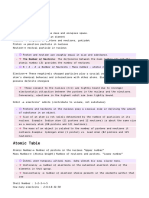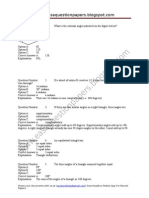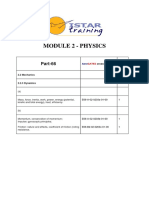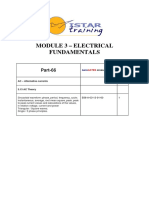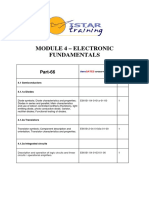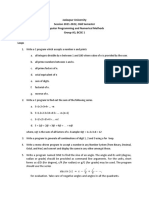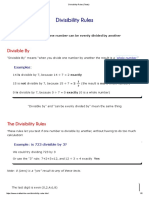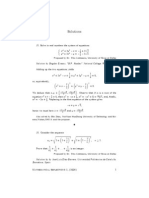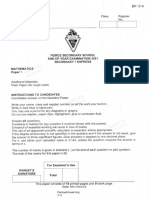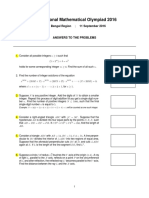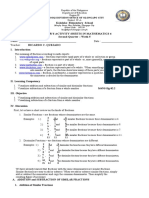0% found this document useful (0 votes)
342 views6 pagesMath Terms for Students
This document defines over 50 common math terms in 1-2 sentences each, including addition, algebra, area, base, binary number system, binomial, circle, coefficient, constant, cosine, cube, cylinder, denominator, diameter, difference, dividend, division, and divisor. It provides concise explanations of essential concepts in mathematics.
Uploaded by
Steven J. SelcukCopyright
© © All Rights Reserved
We take content rights seriously. If you suspect this is your content, claim it here.
Available Formats
Download as PDF, TXT or read online on Scribd
0% found this document useful (0 votes)
342 views6 pagesMath Terms for Students
This document defines over 50 common math terms in 1-2 sentences each, including addition, algebra, area, base, binary number system, binomial, circle, coefficient, constant, cosine, cube, cylinder, denominator, diameter, difference, dividend, division, and divisor. It provides concise explanations of essential concepts in mathematics.
Uploaded by
Steven J. SelcukCopyright
© © All Rights Reserved
We take content rights seriously. If you suspect this is your content, claim it here.
Available Formats
Download as PDF, TXT or read online on Scribd
/ 6
Math Dictionary
#Addition . The process in which the value of one number is added to
the value of another.
#Algebra . The branch of mathematics that uses letters or symbols to
represent numbers in formulas and equations.
#Area . A measurement of the amount of surface inside a two-
dimensional object.
Aspect ratio. The relationship of the length (wingtip to wingtip), or
span, of an airfoil to its width, or chord.
Associative property. The sum or product of two or more terms is the
same regardless of the order in which they are added or multiplied.
#Base . In mathematics, used to refer to a particular mathematical
object that is used as a building block. A base-a system is one that
uses a as a new unit from which point counting starts again. (See
#decimal system.) In the mathematical expression an, read as “a to
the nth power,” a is the base.
#Binary number system. The binary number system is a number system
that has only two digits, 0 (zero) and 1. Binary numbers are made from
a series of zeros and ones. An example of an 8-bit binary number is
11010010. The prefix “bi” in the word binary is a Latin root for the
word “two.”
#Binomial . Aan algebraic expression of the sum or difference of two
terms.
#Circle . A round plane figure whose boundary (the circumference)
consists of points equidistant from a fixed point (the center).
#Circumference(of a circle). The linear measurement of the distance
around a circle. The circumference is calculated by multiplying the
diameter of the circle by 3.1416.
#Coefficient . In algebra, a number placed before and multiplying the
variable in an algebraic expression (i.e., the 2 in 2x).
Commutative property. The sum of term does not change regardless of
the order in which the terms are added.
#Cone . A solid or hollow object that tapers from a circular base to
a point.
#Constant . In algebra, a number that appears on its own (without
being combined with a variable).
#Cosine (cos). A trigonometric function comparing two sides of a
right triangle as follows:
#Cube . A symmetrical three-dimensional shape, either solid or
hollow, contained by six equal squares.
#Cylinder . A hollow or solid object with parallel sides the ends of
which are identical circles.
Decimal system. The number system, also called the base-ten system,
based on the number 10. Consisting of ten symbols, or digits (0, 1, 2,
3, 4, 5, 6, 7, 8, 9), the main principle is that 10 is considered as a
new unit from which point counting starts again.
#Denominator . The lower part of a fraction (represented by the letter
D in N⁄D), the quantity by which the numerator is divided.
#Diameter (circle). The length of a line passing directly through the
center of a circle. Twice the radius of the circle.
#Difference . The answer to a subtraction problem.
Distributive property of multiplication. When multiplication it is
performed on two or more quantities already combined by another
operation, the result is the same as when it is performed on each
quantity individually and the products then combined.
#Dividend . In a division problem, the number to be divided by the
divisor. In 6 ÷ 2 = 3, the dividend is 6.
#Division . The process of finding how many times one number (the
divisor) is contained in another number (the dividend).
#Divisor . In a division problem, the number by which dividend is to
be divided. In 6 ÷ 2 = 3, the divisor is 2.
#Ellipse . A regular oval shape, traced by a point moving in a plane
so that the sum of its distances from two other points (the foci) is
constant, or resulting when a cone is cut by an oblique plane that
does not intersect the base.
#Exponent ( #power ). A shorthand method of indicating how many
times a number, called the base, is multiplied by itself. For example,
in the number 43, the 3 is the power or exponent and 4 is the base.
That is, 43 is equal to 4 × 4 × 4 = 64.
#Expression . In algebra, a collection of symbols that jointly express
a quantity.
#Fraction . A number written in the form N ⁄ D in which N is the
numerator and D is the denominator. For example, 5⁄16 is a fraction.
#Function . A mathematic expression that defines the relationship
between an input and an output.
Graph. A diagram showing the relation between variable quantities,
typically of two variables, each measured along one of a pair of axes
at right angles.
#Hypotenuse . The side of a right triangle that is opposite the right
angle. The hypotenuse is the longest side of a right triangle.
Improper fraction. A fraction with the numerator equal to or greater
than the denominator.
#Index : (plural: indices). The power or exponent of a number.
#Logarithm . A quantity representing the power to which a fixed number
(the base) must be raised to produce a given number.
Linear equation. An equation between two variables that gives a
straight line when plotted on a graph.
Maintenance. This includes inspection, overhaul, repair, preservation,
and the replacement of parts, but excludes preventive maintenance.
Mixed number. A combination of a whole number and a fraction. For
example, 5 3⁄8 is a mixed number.
Monomial. An algebraic expression existing of one term. polynomial.
#Multiplication . The process of repeated addition.
Negative number. A number that is less than zero.
Nomogram. A graph that usually consists of three sets of data.
Knowledge of any two sets of data enables the reader to determine the
third set.
#Numerator . The upper part of a fraction (represented by the letter N
in N⁄D).
Ordered pair. A pair of variable such as (x, y) which describe the
location of a point on a graph. The first variable (x) describes the
distance from the y axis. The second variable describes the distance
from the x axis.
#Parallelogram . A four-sided plane rectilinear figure with opposite
sides parallel.
#PEMDAS . An acronym used to remember the order in which mathematic
operations should be performed.
#Percentage . Used to express a number as a fraction of 100. Using the
percentage sign, %, 90 percent is expressed as 90%.
Place value. The numerical value of a digit by virtue of its position
in a number.
Polar coordinates. A pair of coordinates locating the position of a
point in a plane, the first being the length of the straight line (r)
connecting the point to the origin, and the second the angle (0) made
by this line with a fixed line such as the x axis.
#Polynomial . An expression of more than two algebraic terms, esp. the
sum of several terms that contain different powers of the same
variable(s).
Positive number. A number that is greater than zero.
#Power ( #exponent ). A shorthand method of indicating how many
times a number, called the base, is multiplied by itself. For example,
in the number 43, 3 is the power, or exponent, and 4 is the base. That
is, 43 is equal to 4 × 4 × 4 = 64.
Powers of ten. Also called scientific notation. It is a shorthand
method of depicting very large or very small numbers.
#Proportion . A proportion is a statement of equality between two or
more ratios. The example of A is to B as C is to D can be represented
A:B = C:D or A/B = C/D.
#Pythagoras ' Theorem. An equation used to find the length of a third
side of any right triangle when the lengths of two sides are known.
The Pythagoras' Theorem states that a2 + b2 = c2. The square of the
hypotenuse (side opposite the right angle) is equal to the sum of the
squares of the other two sides (a and b).
#Quadratic equation. An equation in which the variable has a power of
two.
#Quotient . The result of dividing two numbers. Radical sign. The
symbol √, used to indicate the root of a number.
#Radius (circle). Equal to one-half the diameter of a circle.
#Ratio . The comparison of two numbers or quantities.
#Rectangle . A plane figure with four straight sides and four right
angles, esp. one with unequal adjacent sides, in contrast to a square.
Rectangular coordinates. A pair of coordinates measured along axes at
right angles to one another.
#Root . A number that when multiplied by itself a specified number of
times will produce a given number. The two most commonly used roots
are the square root and the cube root.
Scientific notation. Used as a type of shorthand to express very large
or very small numbers. For example, to express 1,250,000,000,000 in
scientific notation is 1.25 × 1012.
Signed numbers. A signed number can be either a positive or negative
number. A positive number is a number that is greater than zero. A
negative number is a number that is less than zero.
Simultaneous equation. Equations involving two or more variables that
have the same value in each equation.
#Sine . A trigonometric function comparing two sides of a right
triangle as follows:
Square root. A non-negative number that must be multiplied by itself
to equal a given number.
#Subtraction . The process where the value of one number is taken from
the value of another.
Slant angle. The direct distance from an aircraft to a input location
on the surface of the earth.
#Sphere . A round solid figure, or its surface, with every point on
its surface equidistant from its center.
#Square . A plane figure with four equal straight sides and four
right angles.
#Sum . The resulting answer in the addition process.
#Tangent (tan). A trigonometric function comparing two sides of a
right triangle as follows:
Term. In algebra, each of the quantities in a mathematic expression.
#Trapezoid . A four-sided figure with one pair of parallel sides.
#Triangle . A three-sided figure in which the sum of the three angles
equal 180°.
#Trigonometry . The study of the relationships between the angles and
sides of a triangle.
#Variable . In algebra, a quantity represented by a letter or symbol
that is assumed to be capable of varying.


